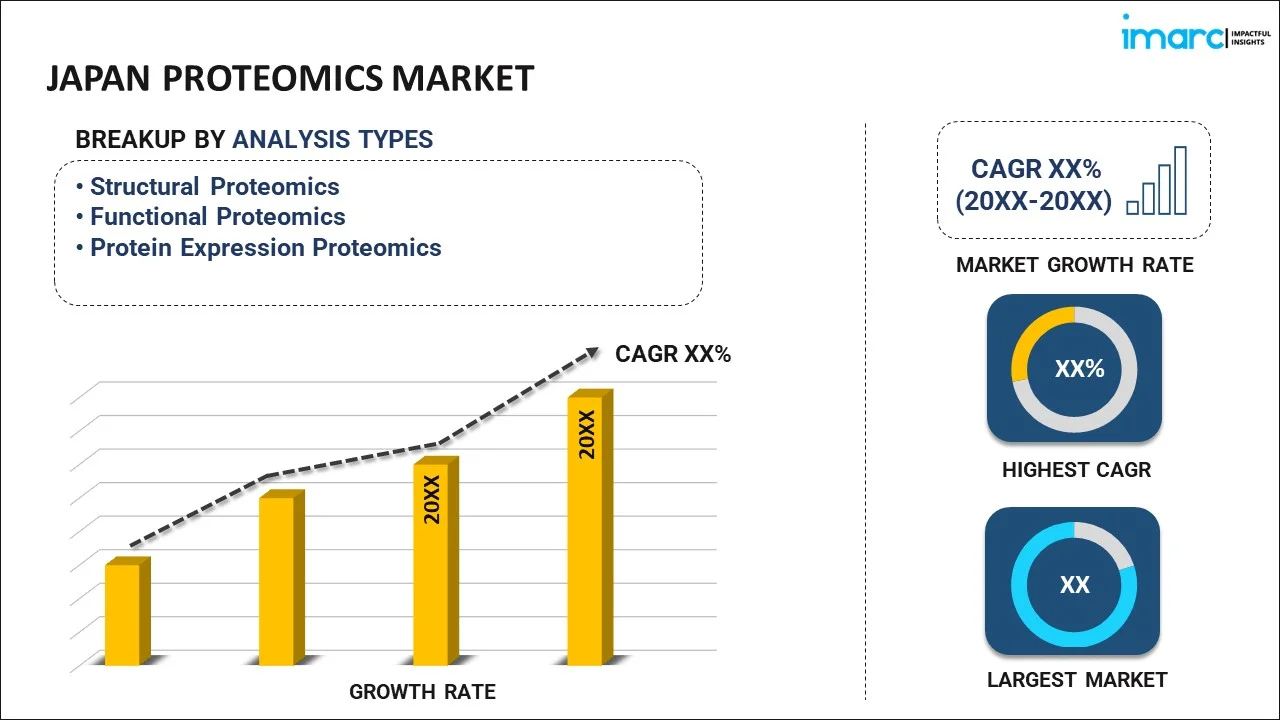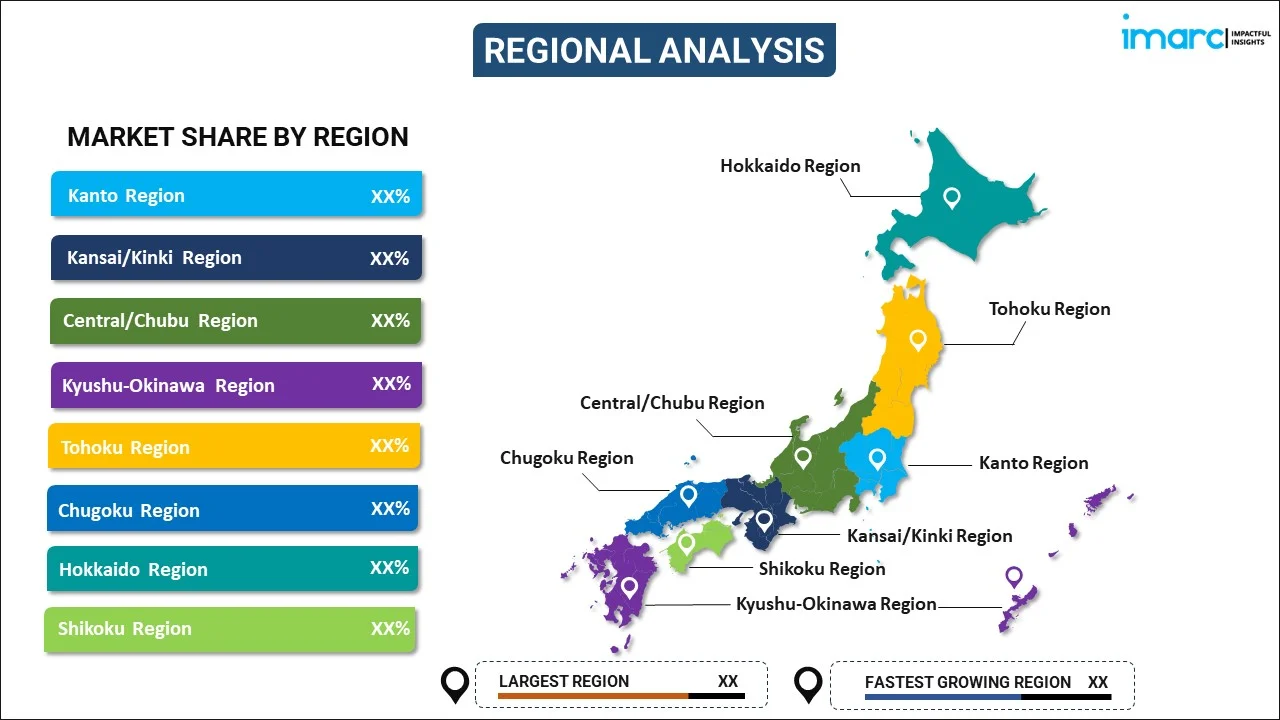
Japan Proteomics Market Report by Analysis Type (Structural Proteomics, Functional Proteomics, Protein Expression Proteomics), Component Type (Core Proteomics Services, Bioinformatics Software and Related Services), Technology (Spectroscopy, Chromatography, Electrophoresis, Protein Microarrays, X-Ray Crystallography, Surface Plasmon Resonance, and Others), Application (Protein Expression Profiling, Proteome Mining, Post-Translational Modifications), End User (Clinical Diagnostic Laboratories, Research Organizations (Drug Discovery), and Others), and Region 2025-2033
Market Overview:
Japan proteomics market size reached USD 2.6 Billion in 2024. Looking forward, IMARC Group expects the market to reach USD 11.6 Billion by 2033, exhibiting a growth rate (CAGR) of 16.7% during 2025-2033. The increasing investments by government bodies in the development of novel drugs are primarily driving the market growth.
|
Report Attribute
|
Key Statistics
|
|---|---|
|
Base Year
|
2024
|
|
Forecast Years
|
2025-2033
|
|
Historical Years
|
2019-2024
|
|
Market Size in 2024
|
USD 2.6 Billion |
|
Market Forecast in 2033
|
USD 11.6 Billion |
| Market Growth Rate 2025-2033 | 16.7% |
Proteomics is the comprehensive study of proteins, encompassing their structures and functions. It delves into how proteins change and adapt under different circumstances. The field investigates the presence and configurations of proteins in both their functional and non-functional states, aiming to discern their specific roles and interactions with other proteins. To achieve this, a range of sophisticated technologies are employed in tandem with proteomics to pinpoint and quantify proteins, as well as to identify potential diagnostic indicators. Additionally, proteomics evaluates the pace at which proteins are produced and maps out their interaction networks. Given these capabilities, proteomics plays a crucial role in advancing drug research and tailoring medicines to individual needs.
Japan Proteomics Market Trends:
In the context of the Japan market, the increasing inclination towards personalized medicine is significantly propelling market growth. This surge is complemented by consistent advancements in biotechnology and drug discovery. Proteomic systems, when implemented, streamline the drug discovery process, becoming integral to the chemical formulation and biological evaluation of multiple medicines. Additionally, Japan's cutting-edge technology and robust research and development (R&D) infrastructure have enabled a nuanced analysis of proteins. This detailed analysis plays a pivotal role in devising cancer treatments, marking a substantial growth factor for the market. The enhancement of Japan's healthcare framework, combined with supportive government policies advocating for research and the discovery of new drugs, further bolsters this upward market trend. Moreover, the market is propelled by the growing integration of technology in detailed protein analysis methods. These methods encompass techniques like Electrospray Ionization-Liquid Chromatography-Mass Spectrometry (ESI-LC-MS), surface plasma resonance, microarray, protein fractionation systems, and X-ray crystallography. Such innovations facilitate an in-depth quantitative and qualitative examination of proteins, aiding in the determination of cancer treatments. Furthermore, regulations by government bodies that promote widespread research and development (R&D) activities are expected to fuel the regional market in the coming years.
Japan Proteomics Market Segmentation:
IMARC Group provides an analysis of the key trends in each segment of the market, along with forecasts at the country level for 2025-2033. Our report has categorized the market based on analysis type, component type, technology, application, and end user.
Analysis Type Insights:

- Structural Proteomics
- Functional Proteomics
- Protein Expression Proteomics
The report has provided a detailed breakup and analysis of the market based on the analysis type. This includes structural proteomics, functional proteomics, and protein expression proteomics.
Component Type Insights:
- Core Proteomics Services
- Bioinformatics Software and Related Services
A detailed breakup and analysis of the market based on the component type have also been provided in the report. This includes core proteomics services and bioinformatics software and related services.
Technology Insights:
- Spectroscopy
- Chromatography
- Electrophoresis
- Protein Microarrays
- X-Ray Crystallography
- Surface Plasmon Resonance
- Others
The report has provided a detailed breakup and analysis of the market based on the technology. This includes spectroscopy, chromatography, electrophoresis, protein microarrays, X-ray crystallography, surface plasmon resonance, and others.
Application Insights:
- Protein Expression Profiling
- Proteome Mining
- Post-Translational Modifications
A detailed breakup and analysis of the market based on the application have also been provided in the report. This includes protein expression profiling, proteome mining, and post-translational modifications.
End User Insights:
- Clinical Diagnostic Laboratories
- Research Organizations (Drug Discovery)
- Others
The report has provided a detailed breakup and analysis of the market based on the end user. This includes clinical diagnostic laboratories, research organizations (drug discovery), and others.
Regional Insights:

- Kanto Region
- Kansai/Kinki Region
- Central/ Chubu Region
- Kyushu-Okinawa Region
- Tohoku Region
- Chugoku Region
- Hokkaido Region
- Shikoku Region
The report has also provided a comprehensive analysis of all the major regional markets, which include Kanto Region, Kansai/Kinki Region, Central/ Chubu Region, Kyushu-Okinawa Region, Tohoku Region, Chugoku Region, Hokkaido Region, and Shikoku Region.
Competitive Landscape:
The market research report has also provided a comprehensive analysis of the competitive landscape in the market. Competitive analysis such as market structure, key player positioning, top winning strategies, competitive dashboard, and company evaluation quadrant has been covered in the report. Also, detailed profiles of all major companies have been provided.
Japan Proteomics Market Report Coverage:
| Report Features | Details |
|---|---|
| Base Year of the Analysis | 2024 |
| Historical Period | 2019-2024 |
| Forecast Period | 2025-2033 |
| Units | Billion USD |
| Scope of the Report | Exploration of Historical and Forecast Trends, Industry Catalysts and Challenges, Segment-Wise Historical and Predictive Market Assessment:
|
| Analysis Types Covered | Structural Proteomics, Functional Proteomics, Protein Expression Proteomics |
| Component Types Covered | Core Proteomics Services, Bioinformatics Software and Related Services |
| Technologies Covered | Spectroscopy, Chromatography, Electrophoresis, Protein Microarrays, X-Ray Crystallography, Surface Plasmon Resonance, Others |
| Applications Covered | Protein Expression Profiling, Proteome Mining, Post-Translational Modifications |
| End Users Covered | Clinical Diagnostic Laboratories, Research Organizations (Drug Discovery), Others |
| Regions Covered | Kanto Region, Kansai/Kinki Region, Central/ Chubu Region, Kyushu-Okinawa Region, Tohoku Region, Chugoku Region, Hokkaido Region, Shikoku Region |
| Customization Scope | 10% Free Customization |
| Post-Sale Analyst Support | 10-12 Weeks |
| Delivery Format | PDF and Excel through Email (We can also provide the editable version of the report in PPT/Word format on special request) |
Key Questions Answered in This Report:
- How has the Japan proteomics market performed so far and how will it perform in the coming years?
- What has been the impact of COVID-19 on the Japan proteomics market?
- What is the breakup of the Japan proteomics market on the basis of analysis type?
- What is the breakup of the Japan proteomics market on the basis of component type?
- What is the breakup of the Japan proteomics market on the basis of technology?
- What is the breakup of the Japan proteomics market on the basis of application?
- What is the breakup of the Japan proteomics market on the basis of end user?
- What are the various stages in the value chain of the Japan proteomics market?
- What are the key driving factors and challenges in the Japan proteomics?
- What is the structure of the Japan proteomics market and who are the key players?
- What is the degree of competition in the Japan proteomics market?
Key Benefits for Stakeholders:
- IMARC’s industry report offers a comprehensive quantitative analysis of various market segments, historical and current market trends, market forecasts, and dynamics of the Japan proteomics market from 2019-2033.
- The research report provides the latest information on the market drivers, challenges, and opportunities in the Japan proteomics market.
- Porter's five forces analysis assist stakeholders in assessing the impact of new entrants, competitive rivalry, supplier power, buyer power, and the threat of substitution. It helps stakeholders to analyze the level of competition within the Japan proteomics industry and its attractiveness.
- Competitive landscape allows stakeholders to understand their competitive environment and provides an insight into the current positions of key players in the market.
Need more help?
- Speak to our experienced analysts for insights on the current market scenarios.
- Include additional segments and countries to customize the report as per your requirement.
- Gain an unparalleled competitive advantage in your domain by understanding how to utilize the report and positively impacting your operations and revenue.
- For further assistance, please connect with our analysts.
 Inquire Before Buying
Inquire Before Buying
 Speak to an Analyst
Speak to an Analyst
 Request Brochure
Request Brochure
 Request Customization
Request Customization




.webp)




.webp)












